-
Instrument Currency Requirements Summarized
-
How to Regain Instrument Currency
- Fly with a Safety Pilot
- Fly with an Instructor
- Get Simulator Training
- Take an Instrument Proficiency Check (IPC)
-
What If 6 Months Pass?
-
Currency Timeline Examples
- Example 1: Up-to-Date Currency
- Example 2: Grace Period Usage
- Example 3: The Need for an IPC
-
Are Six Approaches Enough?
-
Summary
Instrument currency can sometimes become complex, especially if you’re not immersed in Federal Aviation Regulations (FARs) on a daily basis.
This article will explain everything you need to know about instrument currency, including a comprehensive guide to requirements, procedures, and practical applications.
Let’s help you maintain your proficiency so that you can focus on what you do best – flying.
Instrument Currency Requirements Summarized
What is instrument currency?
Simply put, it’s a regulatory requirement ensuring pilots maintain essential skills for safe instrument flight. If you’re an instrument-rated pilot, it means you need to perform certain key activities in the past six months to act as the Pilot in Command (PIC) of an aircraft flying according to Instrument Flight Rules (IFR) (§ 61.57 (c)). This includes flights without passengers.
Let’s break it down further.
To maintain instrument currency, you need to, within the previous six months:
- Perform and log six instrument approaches.
- Execute holding procedures and tasks.
- Intercept and track courses using navigational electronic systems.
You may notice that tracking and intercepting are inherently part of an instrument approach. But the FAA specifically mentions them due to some less common approaches, like Precision Approach Radar (PAR) or Airport Surveillance Radar (ASR), approaches, which don’t rely on the cockpit navigation equipment but rather on Air Traffic Control lateral and vertical navigation instructions.
You don’t need to do all six approaches in six months. In other words, if you do two approaches and another four at a later date, you have a total of six.
Remember to document these tasks meticulously in your logbook as part of your records (this is a legal requirement found in FAR 61.51).

How to Regain Instrument Currency
If your instrument currency lapses, don’t fret; there are several options you can use to regain it.
Fly with a Safety Pilot
The safety pilot option allows you to regain currency by performing the necessary tasks with a safety pilot onboard while wearing a “view-limiting device.”
This safety pilot must have the appropriate category and class ratings and a current medical. They must also be in a control seat during the flight.
Notably, the safety pilot does not need to have an instrument rating.
The key aspect to understand here is that you’re the PIC on this flight, which means you aren’t allowed to fly IFR. Instead, you’re flying VFR and simulating IFR conditions to meet the requirements.
Remember to log the name of your safety pilot in your logbook (another legal requirement from FAR 61.51).
Fly with an Instructor
Another option is to fly with a certified flight instructor. This will allow you to fly IFR, which makes your life a whole lot easier.
You’ll likely have to pay the flight instructor, which makes this option more expensive than a safety pilot. But not needing to stay VFR and “simulate” IFR procedures is a big advantage.
Get Simulator Training
Not keen on real-world flying? Then simulator training might be your go-to solution. The FAA allows you to regain currency through approved flight simulators or flight training devices.
You’ll have to fly a simulator that represents the same category of aircraft you intend to fly under IFR.
Take an Instrument Proficiency Check (IPC)
The most comprehensive way to regain proficiency is through an Instrument Proficiency Check (IPC) with a Certified Flight Instructor (CFI). During this evaluation, you’ll need to demonstrate proficiency in various tasks outlined in the Instrument Rating Practical Test Standards.
We’ll dive further into the IPC later in this article.
What If 6 Months Pass?

If your currency expires (i.e., you haven’t done the six approaches in six months), you have another six months to get current again (known as a “grace period”).
If you let another six months pass, you need an IPC. In other words, if it’s been six months since you did the six approaches, and another six months pass (12 months total) – it’s Instrument Proficiency Check time (§ 61.57 (d)).
An IPC, conducted by a Certified Flight Instructor-Instrument (CFII) or an examiner, evaluates your IFR flying skills. This includes a variety of maneuvers and procedures, in varying simulated weather conditions, to ensure you can handle a wide range of IFR situations. It’s practically the same as your initial instrument check-ride.
If you pass, congratulations! You regain your instrument currency, valid from the month you completed the IPC. If you don’t, don’t sweat it. You’re provided detailed feedback and ample opportunity to correct your deficiencies.
Remember, the IPC isn’t a punishment but a tool designed to ensure pilot competency and safety. And, sometimes, we all need a refresher!
Currency Timeline Examples
Understanding instrument currency can be a bit daunting. To help bring some clarity, let’s walk through some timeline examples.
Example 1: Up-to-Date Currency

Imagine it’s June, and you conducted six approaches, holding procedures, and course tracking in March. You’re still within the 6-month period, so you’re instrument current and good to go.
Example 2: Grace Period Usage

Now, suppose it’s October, and you completed those six approaches back in March. You’ve stepped into the 6-month grace period. You can still regain your currency by performing six approaches, holding procedures, and course tracking, but this time, it must be with a safety pilot, flight instructor, or in a simulator.
You can also take an IPC to regain currency, but it is not required.
Example 3: The Need for an IPC

If it’s April the following year and your last six approaches were in March the previous year, you’re now beyond the 6-month grace period (12 months total).
To regain your instrument currency, you need to undergo an Instrument Proficiency Check (IPC) with a Certified Flight Instructor-Instrument (CFII) or examiner.
These examples illustrate the ongoing cycle of maintaining and regaining instrument currency. It’s all part of the journey of being an instrument-rated pilot, keeping you and your passengers safe in the skies.
Are Six Approaches Enough?

Instrument currency and instrument proficiency are two sides of the same coin, and it’s important not to confuse them. Performing six approaches, holding procedures, and course tracking in a six-month period makes you legally current, as outlined in Federal Aviation Regulations (FARs). But does it make you proficient?
Proficiency implies a deeper level of skill than mere currency. It means being thoroughly competent and comfortable in managing a broad range of instrument flight scenarios. While the regulatory minimum of six approaches might ensure you’re current, it doesn’t necessarily mean you’re proficient.
The number of approaches you need to feel proficient can vary widely. Some pilots may find six approaches sufficient, particularly if they fly frequently and in a variety of conditions or make use of a home flight simulator. Other pilots, perhaps those who fly less often or mostly in fair weather, may find that they need more than six approaches to feel truly comfortable and safe flying under instrument flight rules.
Remember, the primary goal is always safety. If you’re unsure about your proficiency, consider seeking additional training or practice beyond the minimum requirements. It’s better to invest time and resources in your skills now than to find yourself ill-prepared in a challenging flight situation. Keep honing your skills, and don’t be shy about seeking help from a Certified Flight Instructor (CFI) or using a simulator to sharpen your IFR abilities.
Summary
Instrument currency is undeniably a complex aspect of aviation, requiring continuous attention and adherence to Federal Aviation Regulations (FARs). However, with a sound understanding of the requirements and processes outlined in this guide, you can confidently navigate these complexities.
Remember, the currency is not synonymous with proficiency. Meeting the minimum requirements of six approaches, holding procedures, and course tracking within six months makes you legally current, but not necessarily proficient. True proficiency is built upon continuous learning, practice, and reflection, transcending mere regulatory compliance.
Whether you choose to regain your currency with a safety pilot, a certified flight instructor, a simulator, or by taking an Instrument Proficiency Check (IPC), the goal remains the same: to uphold safety and competency in the skies. Should you find yourself needing to regain instrument currency, embrace it as an opportunity to refresh your skills and enhance your knowledge.
In this ever-evolving field of aviation, maintaining instrument currency is more than a regulatory requirement; it is a commitment to excellence in flight safety. It’s about ensuring you’re not just qualified to fly under IFR, but that you’re comfortable, competent, and confident in your ability to do so.
Safe flying to you, and never hesitate to seek additional training or guidance when needed. Your proficiency and safety are worth it.



